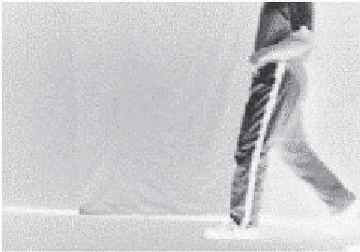Image Processing Reference
In-Depth Information
the value selected manually, and so the thresholded image does omit some detail around
the eye, especially in the eyelids. However, the selection by Otsu is
automatic
, as opposed
to
manual
and this can be to application advantage in automated vision. Consider, for
example, the need to isolate the human figure in Figure
3.10
(a). This can be performed
automatically by Otsu as shown in Figure
3.10
(b). Note, however, that there are some extra
points, due to illumination, which have appeared in the resulting image together with the
human subject. It is easy to remove the isolated points, as we will see later, but more
difficult to remove the connected ones. In this instance, the size of the human shape could
be used as information to remove the extra points, though you might like to suggest other
factors that could lead to their removal.
(a) Thresholding at level 160
(b) Thresholding by Otsu (level = 127)
Figure 3.9
Thresholding the eye image: manual and automatic
(a) Walking subject
(b) Automatic thresholding by Otsu
Figure 3.10
Thresholding an image of a walking subject
The code implementing Otsu's technique is given in Code
3.4
which follows Equations
3.11 to 3.16 to directly to provide the results in Figures
3.9
and
3.10
. Here, the histogram
function of Code
3.1
is used to give the normalised histogram. The remaining code refers
directly to the earlier description of Otsu's technique.





















